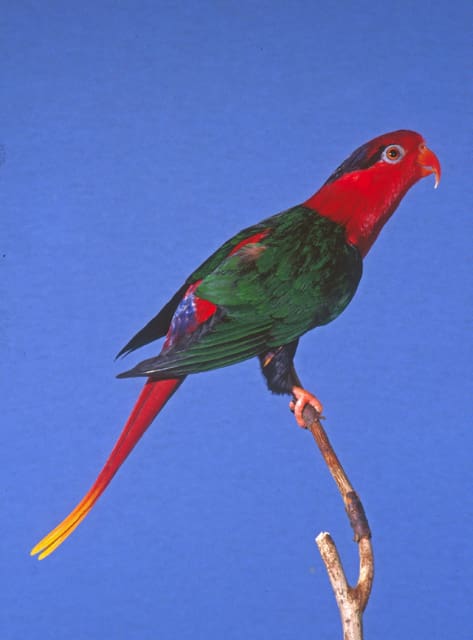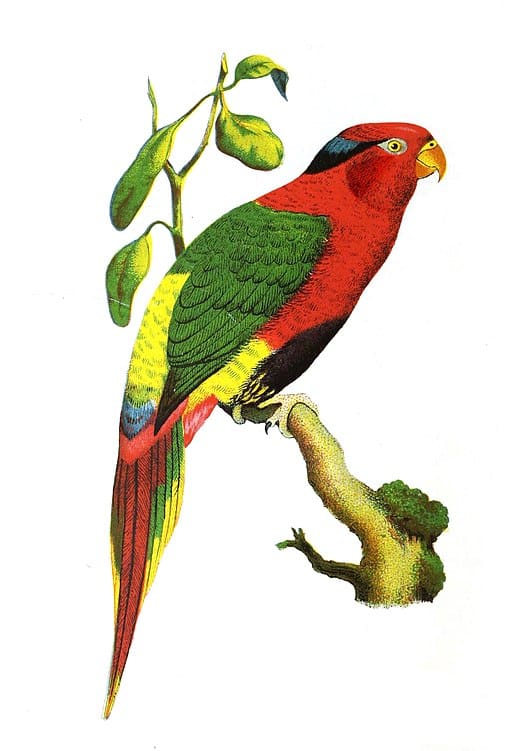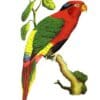Josephine’s Lorikeet
Also known as:
Josephine's Lory
Also known as:
Josephine's Lory

Charmosyna

josefinae
Size:
24 cm (9.3 in)
Weight:
68 g (2.4 oz)
Subspecies including nominate:
three: C.j. josefinae, C.j. cycloporum, C.j. sepikiana
Colour Adult:
C.j. josefinae: Male-in general red; black occiput to nape, with pale lilac/blue streaking towards front; rump has dusky blue patch; black lower flanks and lower abdomen; red underwing coverts; red central tail feathers tipped with yellow; lateral tail feathers red washed with green on outer webs and tipped with yellow. Beak orange. Eye yellow. Female-green/yellow lower back.
C.j. cycloporum: Both adults have black abdominal patch; blue streaking on occiput missing or faint.
C.j. sepikiana: Male-black abdominal patch more extensive; pale grey streaking on occiput. Female-as in male, but with yellow lower back and flanks.
Colour Juvenile:
C.j. josefinae: As in adult female but with green wash to black thighs and abdomen; green wash on occiput to nape; blue/green streaking on occiput; underwing band dull yellow. Beak brown. Eye brown.
C.j. sepikiana: In general duller than male; green wash on black thighs, abdomen and occiput to nape.
Call:
Calls given in flight are described as high-pitched; nasal note while perched reminescent of Papuan Lorikeet (Charmosyna papou).
More Information:
Content Sources:
CITES
The Lory Link
BirdLife International
Cornell Lab of Ornithology/Birds of the World
Parrots: A Guide to Parrots of the World, Juniper and Parr, 1998
Parrots of the World, Forshaw, 2006. 2010 edition
Lexicon of Parrots, Thomas Arndt.
Parrots in Aviculture, Low, 1992.
Captive Status:
Rare
Longevity:
25-35 yrs
Housing:
Aviary with well-drained (sloping concrete with outlet drain), tiled floor and surround.
Diet:
Nectar – a commercial type or homemade from: lactose-free baby cereal, honey and malt extract or molasses, mixed with filtered water and made fresh once or twice daily, with wheat germ added if desired; fruits once or twice daily such as: apple, pear, orange, cactus fruits, bananas and one or more of the following daily: carrot, fresh raw corn on the cob or tinned, unsalted sweet corn, green leave such as: Swiss chard, lettuce, kale, sowthistle, chickweed, dandelion; rearing food made from: hard boiled egg, wholegrain bread and carrot, all ground to crumbly consistency.
Enrichment:
Provide plenty of branches for climbing and stripping bark, willow, elder or saskatoon; also provide overhead misters and shallow water bowls for daily bathing. Keep no less than 22 C (72 F) during acclimatisation.
Nest Box Size:
Vertical box 10 cm x 10 cm x 25 cm (4 x 4 x 10 in).
Clutch Size:
2
Fledging Age:
8 weeks
Hatch Weight:
—
Peak Weight:
—
Weaning Weight:
—
World Population:
Unknown; described as sparse and local throughout its range. Decreasing.
IUCN Red List Status:
Least Concern
CITES Listing:
Appendix II
Threat Summary:
May be uncommon throughout most parts of its range, although sightings may be few due to its shy behaviour. Trade is likely not a threat, although 697 were exported in 1986 and 459 in 1987. Numbers are reported to be sparse and local throughout most of its range. Is considered to have a medium dependency on forest habitat and tree cover is estimated to have declined by 2.9% within its range over the past three generations. Therefore, it is tentatively suspected that this may have led to a 1-19% population decline over the same time frame.
Range:
C.j. josefinae: Mountains of Vogelkop east to Snow Mountains, West Papua.
C.j. cycloporum: Cyclops Mountains, West Papua.
C.j. sepikiana: Mountains of W Papua New Guinea, in Sepik River region and Western Highlands east to Jimi River valley and Mount Bosavi.
Habitat:
Found from 750-2200 m (2460-7216 ft) in montane forest, forest edges and partly cleared areas.
Wild Diet:
Feeds on nectar, pollen and flower buds taken in canopy trees and mid-storey epiphytes; a climbing vine with large white flowers also noted.
Ecology and Behaviour:
May be nomadic. Usually seen in pairs or small groups. Is fairly difficult to spot in spite of its bright colouration. Feeds in the canopies of flowering trees, on flowering vines or mid-storey epiphytes.
Clutch and Egg Size:
2 eggs
Breeding Season:
A single record of a bird in breeding condition in February.
Related Links:
—



